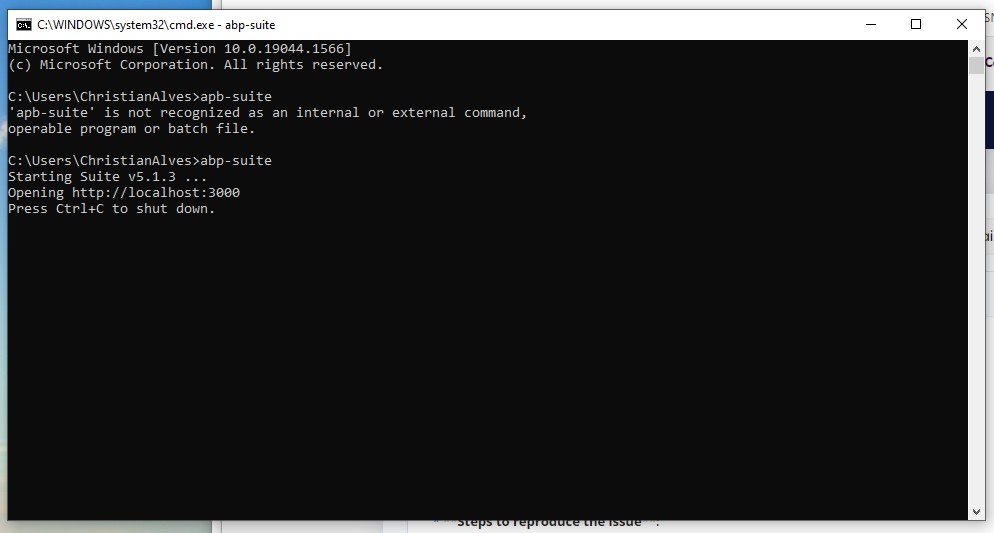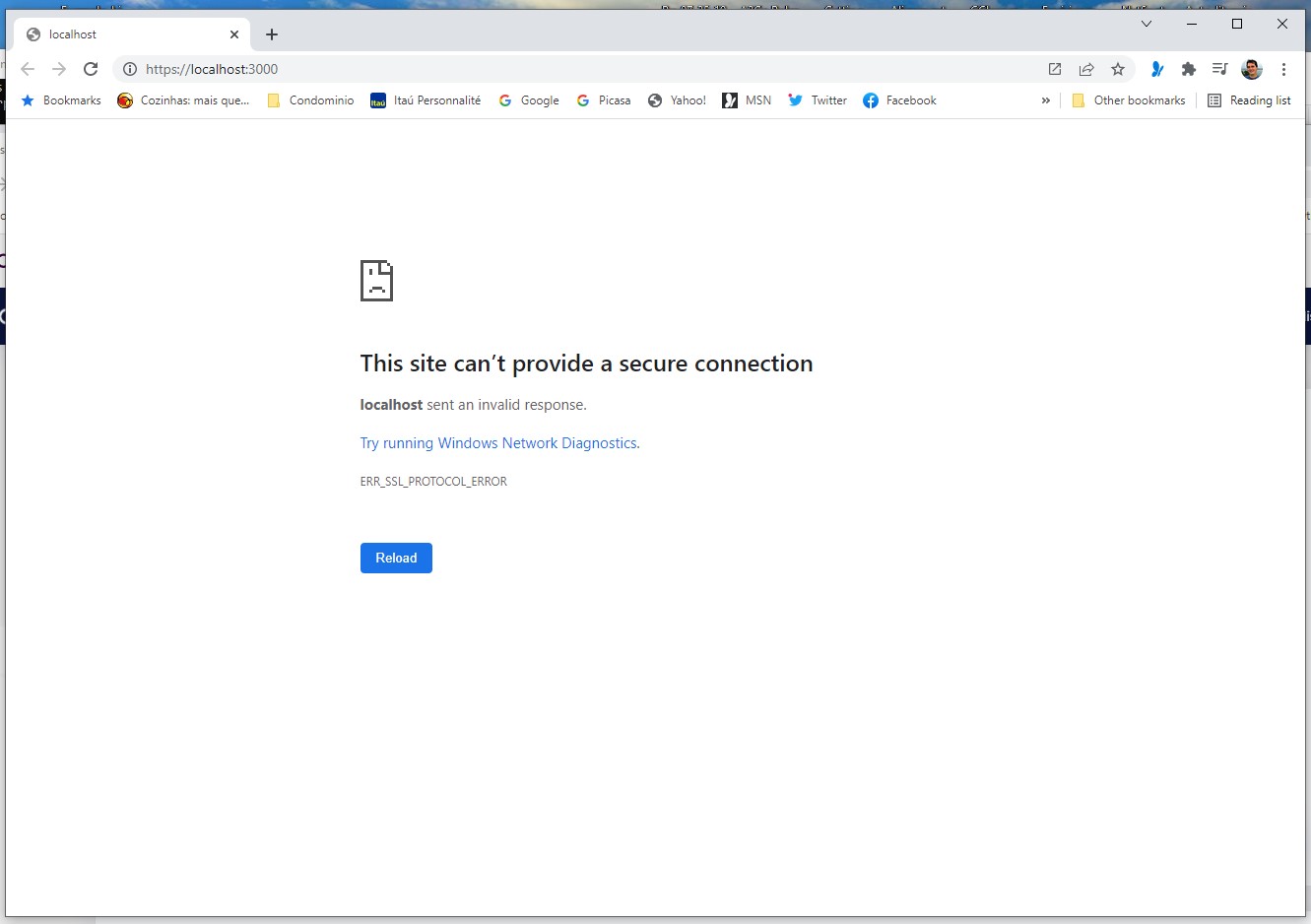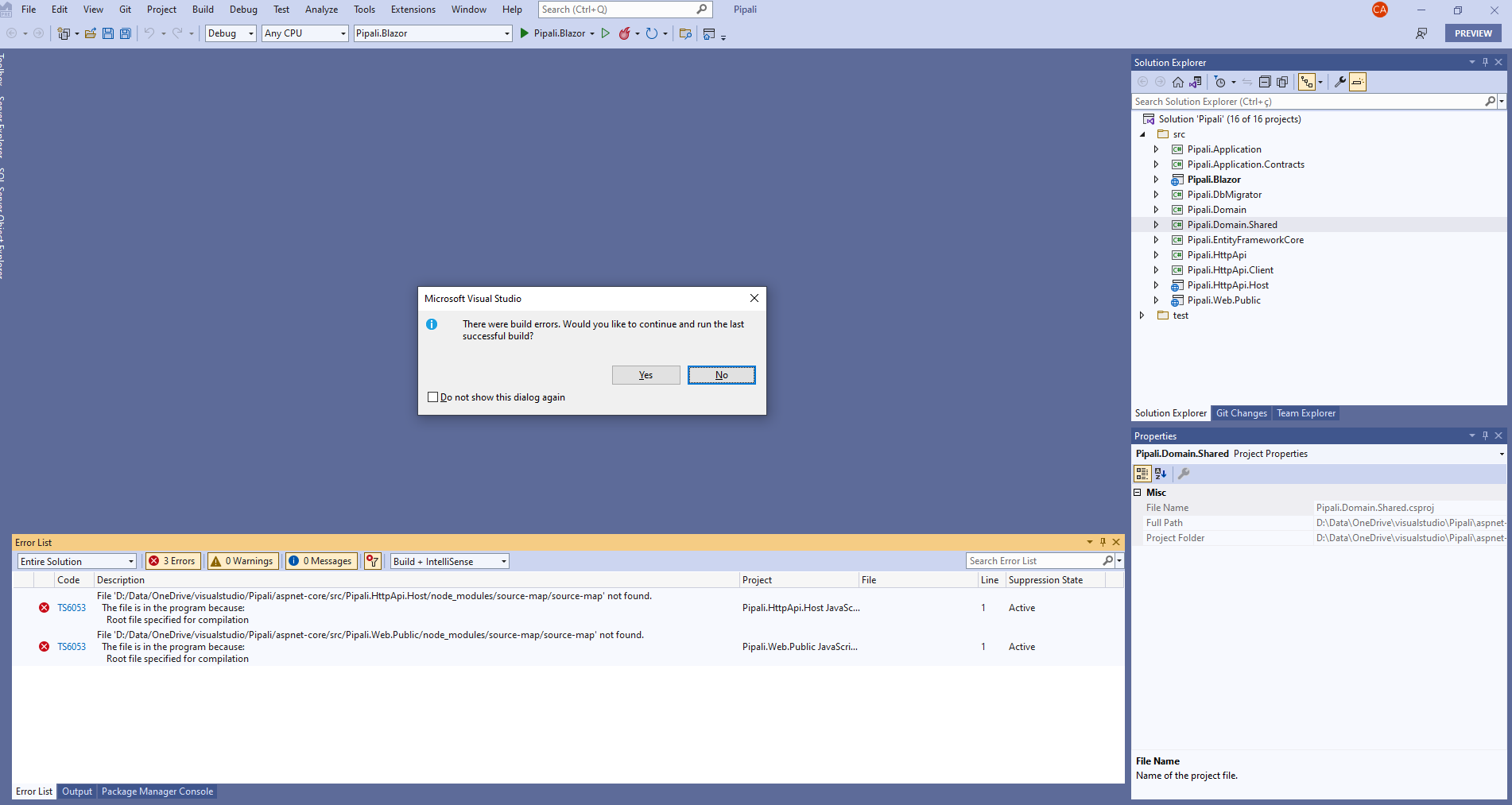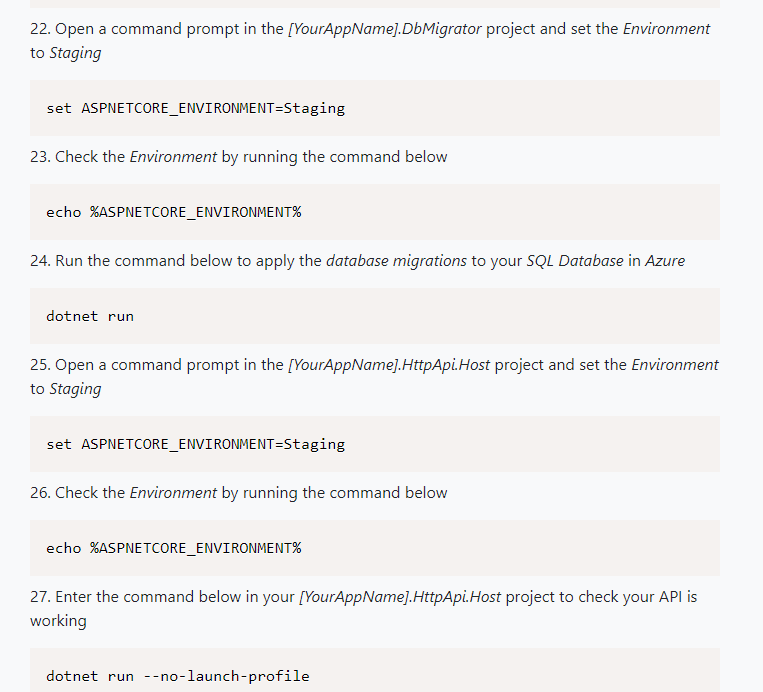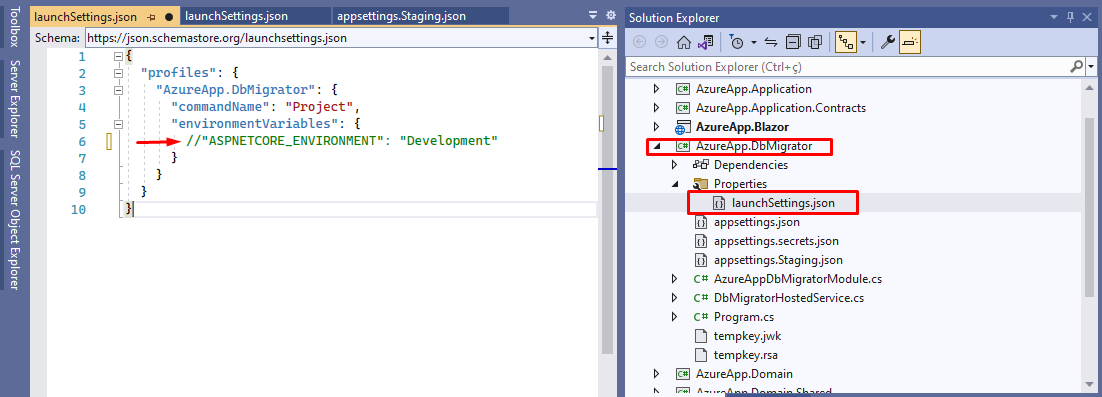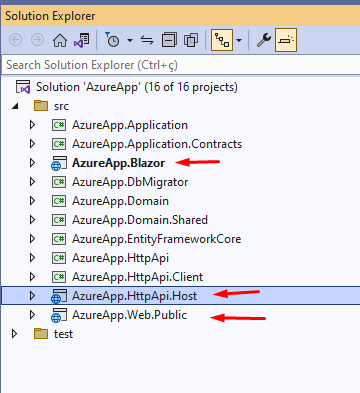Activities of "chrisalves"
Hi,
I was working today with ABP Suite and also with Visual Studio for Windows, building a new solution. I realized that the ABP suite stopped work and I closed the command prompt and tried to run/load it again. I realized the Suite was not being launched in the browser, so I rebooted the pc few times, also removed the ABP suite, rebooting again. Reinstalled and the same problem persists. I cleaned browser cache and history, but it is still the same, not being loaded.
Any thoughts about it?
Bellow you will see the answers required, also two screen shots for the command prompt and the browser. Thanks for your support.
If you're creating a bug/problem report, please include followings:
Additionally, I tried to launch without https, only http, and I got the same message in the browser.
Using Google Chrome, it always replace http for https. If I open in Microsoft Edge, it runs OK. But in Chrome, the URL always is being replaced by https .
- ABP Framework version: v5.2.0
- ABP Suite: Yes, v5.2.0
- Template Type: Application Template
- UI type: Blazor WebAssembly
- DB provider: EF Core
- Database: SQL Server
- Tiered (MVC) or Identity Server Separated (Angular): There is no separated Identy Server.
- Exception message and stack trace: Blazor App error when run using Visual Studio (CTRL+F5)
- Steps to reproduce the issue:" I created a simple application to try the feature Many-to-Many, with a single field (name) considering 2 entitys (product and catalog). The application worked fine, I was able to run the HttpApi.Host and Blazor. After that, I decided to create additional fields on ABP Suite in the Entity Products. After that, I selected to "Save and Generate". This process took a long time and at the end I saw an error message related to the Migration. I repeated few times the execution of "Save and Generate" but now it runs without problem but something was not done in the solution because the Blazor is not running anymore.
If I select to run the Last Sucessful build, it runs but it does not present the new fields created. I do not know how to solve the issues related to this Bulld errors.
If you're creating a bug/problem report, please include followings:
- ABP Framework version: v5.2.1
- UI type: Blazor WebAssembly
- DB provider: EF Core
- Tiered (MVC) or Identity Server Separated (Angular): no
- Exception message and stack trace: None
- Steps to reproduce the issue:"
Hi Folks,
I developed a simple application using Blazor WebAssembly to be hosted in Microsoft Azure, througth the Static Web App technology. The application name is eOrdering, the ideia is to be an application to allow small bakeries and restaurants to offer Online Ordering to their customers for takeawey or delivery of products.
The projects inside the Solution are named using ABP convention like eOrdering.Blazor, eOrdering.HttpApi.Host etc.
To create the Azure Machine is quite simple cause Azure offers a Wizard to set the machine and the Github settings to get access repository/branch to implement the CI-CD automation.
The machine has a public and fixed host name like https://somename.azure.com but it can be changed in the future for a custom domain name.
The beauty of this ci-cd is to allow to update the app version inside the machine when there is a new version published in Github. Everytime I commit the branch, the Github updates the Azure Machine content. It is very common nowadays but I´m describing here to make the case clear.
I have 3 branches in the GitHub (Development, Test, Production) and each of them is integrated with a distinct Azure Machine. Once there is an update in the Development branch, the new code is automatically deployed to Azure Machine-dev and need to access the correct API. When there is a change in the Test branch, the new code is automatically deployed to Azure Machine-tst, and the same situation occurs when updating the Production branch.
In my personal PC where I have ABP installed and Visual Studio to run, I can see the both applications running correctly (the API and the FrontEnd) but when I publish them to Azure, the FrontEnd doesn't find the API.
What kind of configuration should I need to add to Blazor frontend application (or another dependency project) to allow the application understands that is being hosted by a given machine and use the correct path to start the communication with the correct backend API (in the case the project eOrdering.HttpApi.Host) hosted in another manhine)?
Many thanks!
Hi! I really appreciate your help! I found the file in the wwwroot folder of the Blazor Project as seen below and now I will work to provide multiples environments according to the MS article suggested.
I do appreciate your help!
According to the article you suggested, I will create the variables in Azure Static App that hosts the Blazor Application.
Many thanks!
Hi Folks,
I'm returning here with the same topic, after some tests made without expected results, the application is not being redirected as expected driven by the aspsettings.{ENVIRONMENT}.json
Considering the environment in Azure is more dificult to diagnose, I spend much time trying to solve, even rising a ticket with MS Technical support. After some researches on the web, I found an article in ABP.IO community that seems to be useful but probably was written for an old version of ABP Framework. The main idea is to present a way to integrate ABP.IO projects into Azure Webapp. Here is the article https://github.com/bartvanhoey/AbpIoAzureDevopsRepo
I found in the article a suggestion to run the application locally in the PC but pointing the Database to the SQL server hosted in Azure (remote database). Following the suggestion to set locally the json file and set the envonment correctly (please see the picture below) as cutted off from the article in the part 3 (https://abpioazuredevopsblazor.azurewebsites.net/part3)
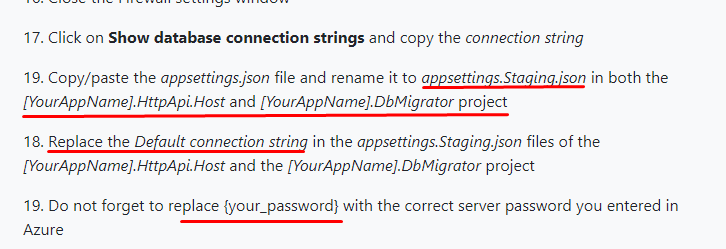
I skipped the section 20 of the article because if applying the recommened changes the code runs and get error. I believe it is because the recently ABP.IO release is not accepting the old code related to "BuildConfiguration()" because the actual release (5.2.1) has the template for Blazor WASM with a different implementation as shown below:
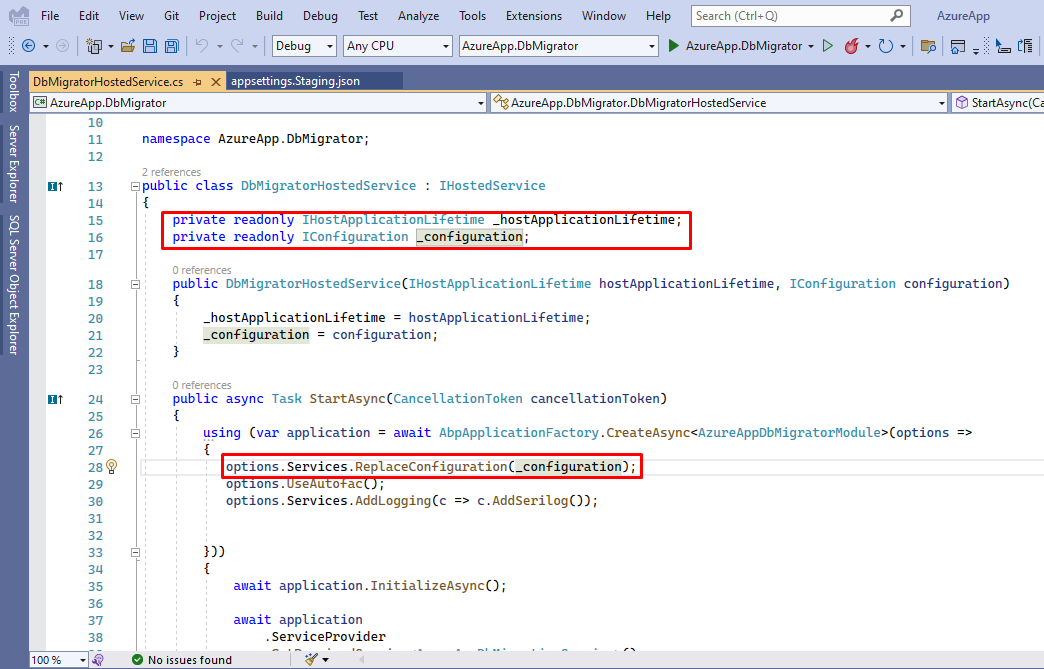 (Default implementation when using Blazor WASM template)
(Default implementation when using Blazor WASM template)
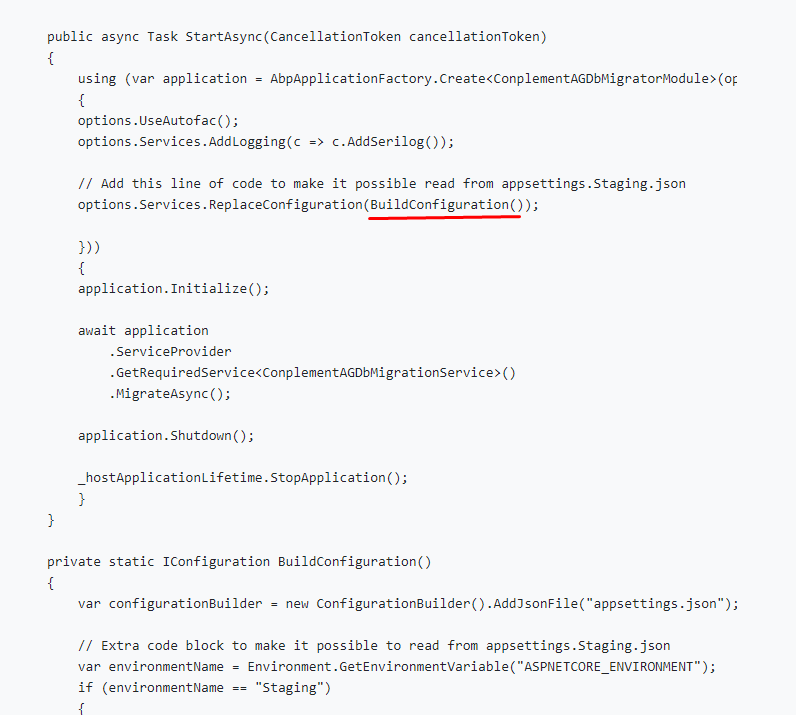 (Changes recommended by the article in the section 20)
(Changes recommended by the article in the section 20)
To test the environment settings, I followed the recomendations below
The picture below reproduces that I´m trying to setup the Staging environment.
The Seed process is always creating ans seeding data in my PC local database, not into the remote hosted by Azure. To ensure this symptom, I deleted the local database many times and ran again, always observing the local database being created again and again.
When I run the {ApplicationName}.HttpApi.Host with Enviroment set as "Development" then it runs perfectly, but when I set the Environment to "Staging" the API runs with error, and loops indefinitely getting errors. My guess is that the Json file is being considered by the {ApplicationName}.HttpApi.Host but it does not find the initial Seed of the database.
Please can anyone help with complementary procedures to allow the first step related to the database connection for a different environment than the default Development?
Many thanks!
Christian
<br>
Hi Folks, Thanks for the reminder about the app type. Additional to the parameter, I needed to comment out the environment variable existing in the file "launchSettings.json" under DbMigrator "properties" because every time I did run the DbMigrator project, the "launchSettings.json" environment variable overrides the Operating System variable. So, it is good to comment out the environment variable if anyone is running in their local PCs.
Many thanks for all your help! I really appreciate it! 😊😊😊
Check the docs before asking a question: https://docs.abp.io/en/commercial/latest/ Check the samples, to see the basic tasks: https://docs.abp.io/en/commercial/latest/samples/index The exact solution to your question may have been answered before, please use the search on the homepage.
If you're creating a bug/problem report, please include followings:
- ABP Framework version: v5.2.2
- UI type: Blazor
- ABP Suite: Yes
- ABP Suite Version: v5.2.2
- DB provider: EF Core
- Tiered (MVC) or Identity Server Separated (Angular): no
- Soution has Public Web Site project: Yes
- Exception message and stack trace:
- Steps to reproduce the issue:"
I created Solution containg a Blazor App, Web API ({appname}.HttpApi.Host) and Public Website using ABP Suite as shown by the picture below:
At this moment the solution was created with no additional entities. The solution containing multiples projects (Blazor App, Wep API, Public WebSite) was synchronized with Github repository, additionally it was created 3 branches named "Development", "Staging" and "Main" to allow 3 distinct environments for the software lifecycle.
We created the Microsoft Azure WebApps integrated with Github using the standard Azure wizard during the WebApp creation process (using the wizard), and just set manually the project path to the CSPROJ file in the YAML for each project. We created a "Azure Cache for Redis" service in Microsoft Azure to support the "Public Website" considering the documentation requirements to have Redis available for caching the Public Website. We created 3 distinct database instances using Azure SQL Server to support each of 3 environments.
The WebAPI is published on each AzureWebApp pointing to the right database instance.
How can we propagate the Database Migrations when we create or change any Entity using ABP Suite? In the Local Database at my PC where I´m running ABP Suite, the changes were applied automatically by ABP Suite. Once I sync with the remote repository and commit using Github to "Development" branch, the Github automation starts a new deployment to Azure WebApp instance but I could not find a way to apply the changes to remote database instance automatically, the only way I could do this migration was by running manually the project DbMigrator existing in my PC (using DOTNET RUN inside the DbMigrator folder) pointing to the remote Database Instance, applying the changes manually. How can I apply the migration/changes to the Database when the new release of the WebAPI is deployed and is required to update the database instance? Is there any solution embebed WebAPI project to verify the database instance and apply the migrations?
Best regards,
Christian
Hi Folks,
I know that the file aspsetting.json can be customized for each environment and the connection string for each environment is already set as the picture below shows:
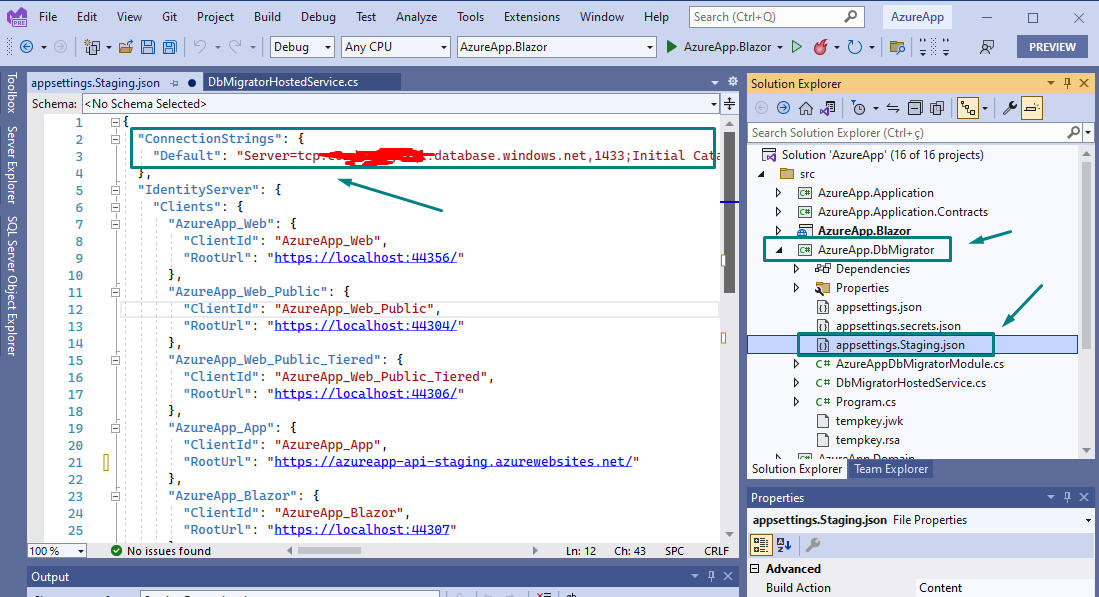
Similar aspsettings.json file can be prepared to development, production or any other environment. This is not the problem.
The question is: how to make make the WebApi implemented by "{appname}.HttpApi.Host" to understand that there is a migration pending and apply the migration to the Database once the new release is launched in the remote server? Is it possible to refer explain how to implement it? Or is there another strategy recommended by ABP.IO to deploy the application to multiples environments?
